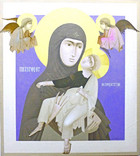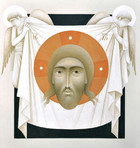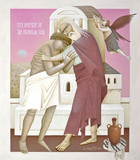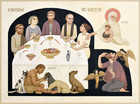Fikos
(b. 1987)
Fikos is one young, modern icon-maker you are more likely to find up a ladder with a paint bucket and brush making street art on some wall somewhere in the world than in a studio hunched over a wooden panel. He has created larger than life acrylic images of the Hesperides evening nymphs for a Canvas of the Streets festival in Morocco; Pegasus the Flying Horse in a school yard in Romania; the Priestesses of Aphrodite in the red light district of Nicosia, Cyprus; and, in his most ambitious project to date, a 46-meter-high painting of an angel embracing an earth goddess on an apartment block in Kyiv, Ukraine.
Mythological gods and folk tale heroes predominate in these monumental murals in public spaces from Barcelona to Bangkok, but what Fikos describes as their “Contemporary Byzantine Painting” style comes directly out of his training in Eastern Orthodox icon-making. He believes this time-honored method of using recognizable figure prototypes in simple compositions that can be adapted to the cultures where they are made gives his paintings a universality lacking in modern art forms that are all about self-expression.
Born in Athens in 1987, the artist’s first “copybooks” were actually Marvel and DC comic strips. An icon he made at the age of 10 won a church school art competition, and he was apprenticed three years later to Greek Iconographer George Kordis, working for the next five years on church commissions with this leading contemporary proponent of a sacred art style blending the old and new. The experience taught Fikos (his artistic nom de plume) to view tradition simply as a “tool,” honed by "thousands of people working over thousands of years"--and, he adds, “None of these dead people can forbid anyone from doing anything.”
Fikos has become such a master of his craft you may sense something novel in his four religious pieces in the Sacred Art Pilgrim Collection without immediately recognizing how they differ from traditional icons. The usual palette of reds and blues gives way in these works to muted pastel shades of rose. Angel wings, feet, and a hanging cloth protrude outside the picture planes to create an illusion of realism and depth. Faces, figures, and folds of drapery are rendered as molded forms in space rather than defined with lines and highlighting.
The icon-mural-maker’s innovations owe much to Greek writer, theologian, and painter, Photios Kontoglou, who inspired a renaissance in Byzantine-styled art, both sacred and secular, in early 20th century Greece. Says Fikos: “[Kontoglou] proved that a person who lived in the 20th century, who has studied in the Paris of Modernism, paints by the light of an electric lamp on canvas, and uses acrylics cannot possibly work in the same way as a painter who lives in the 13th century and has never left the boundaries of Byzantium.”
An inveterate globe trotter, Fikos travels the world with eyes open for what he calls that “small fragment of gold…to add on the crown of the long history of Byzantine art.” His border crossings are not just geographical. Like Kontoglou before him, Fikos is also pushing the limits of this ancient art form with both small icons on Japanese paper and huge murals on multi-storied buildings--maybe, coming someday soon to the neighborhood where you live!
For more information about Fikos, connect to his interview in the Orthodox Arts Journal: https://www.orthodoxartsjournal.org/contemporary-byzantine-painting/





